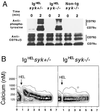Role of Syk in B-cell development and antigen-receptor signaling
- PMID: 10677523
- PMCID: PMC26501
- DOI: 10.1073/pnas.97.4.1713
Role of Syk in B-cell development and antigen-receptor signaling
Abstract
Antigen receptors (BCRs) on developing B lymphocytes play two opposing roles-promoting survival of cells that may later bind a foreign antigen and inhibiting survival of cells that bind too strongly to self-antigens. It is not known how these opposing outcomes are signaled by BCRs on immature B cells. Here we analyze the effect of a null mutation in the Syk tyrosine kinase on maturing B cells displaying a transgene-encoded BCR that binds hen egg lysozyme (HEL). In the absence of HEL antigen, HEL-specific BCRs are expressed normally on the surface of Syk-deficient immature B-lineage cells, but this fails to promote maturation beyond the earliest stages of B-lineage commitment. Binding of HEL antigen, nevertheless, triggers phosphorylation of CD79alpha/beta BCR subunits and modulation of receptors from the surface in Syk-deficient cells, but it cannot induce an intracellular calcium response. Continuous binding of low- or high-avidity forms of HEL, expressed as self-antigens, fails to restore the signal needed for maturation. Compared with the effects in the same system of null mutations in other BCR signaling elements, such as CD45 and Lyn kinase, these results indicate that Syk is essential for transmitting a signal that initiates the program of B-lymphocyte maturation.
Figures





References
Publication types
MeSH terms
Substances
Grants and funding
LinkOut - more resources
Full Text Sources
Other Literature Sources
Molecular Biology Databases
Research Materials
Miscellaneous

